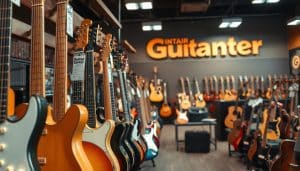Finding the perfect bass guitar amp can be a daunting task, especially with so many options available. But fear not, because the ultimate guide to choosing the best bass guitar amps is here to help you navigate through the sea of choices. Whether you’re a seasoned bassist or just starting out, this comprehensive guide will provide you with all the information you need to make an informed decision. From understanding different types of amps to considering wattage and features, this article will equip you with the knowledge you need to find the best bass guitar amp that perfectly suits your needs and preferences. Get ready to take your bass playing to the next level!

The Ultimate Guide to Choosing the Best Bass Guitar Amps
When it comes to playing the bass guitar, having a good amplifier is essential for achieving the right tone and projection. With so many options available in the market, it can be overwhelming to choose the best bass guitar amp for your specific needs. In this comprehensive guide, we will explore the different types of bass guitar amps, important considerations before making a purchase, and popular brands to consider. Let’s dive in!
1. Types of Bass Guitar Amps
1.1. Combo Amps
Combo amps are a popular choice among bass players due to their convenience and portability. These amps combine the amplifier and speaker in one compact unit, making them easy to transport and set up. Combo amps come in various sizes and wattages, with some models even offering built-in effects and additional features. If you’re a beginner or a gigging musician who values simplicity and ease of use, combo amps are a great option to consider.
1.2. Head and Cabinet
Head and cabinet setups offer more flexibility and customization options compared to combo amps. With this configuration, the amplifier head is separate from the speaker cabinet, allowing you to mix and match different components based on your preferences. This setup is favored by professional musicians and bass enthusiasts who want to fine-tune their tone by selecting specific speakers and cabinets. However, it’s important to note that head and cabinet setups can be bulkier and require more effort to transport.
1.3. Stack Amps
If you’re looking to make a statement both visually and sonically, stack amps are the way to go. These setups consist of multiple speaker cabinets stacked on top of each other, creating a powerful and commanding presence on stage. Stack amps are commonly used in large venues and outdoor performances where high volume and projection are crucial. While stack amps deliver exceptional sound, they can be quite heavy and require careful handling.
1.4. Tube Amps
Tube amps, also known as valve amps, are revered for their warm and rich sound characteristics. They use vacuum tubes to amplify the signal, resulting in a smooth and vintage tone that many bass players adore. Tube amps are highly responsive to touch and dynamics, making them ideal for musicians who value expressive playing. However, tube amps can be more expensive and require regular maintenance, including tube replacements.
1.5. Solid-State Amps
Solid-state amps use transistors and integrated circuits to amplify the signal, offering a more reliable and affordable alternative to tube amps. They are known for their durability and consistent performance, making them suitable for gigging musicians who require a robust and dependable amplifier. Although solid-state amps may not possess the same warm and nuanced sound as tube amps, they excel in delivering clean and precise tones, making them a popular choice for genres such as funk and rock.

2. Considerations Before Buying
When selecting a bass guitar amp, there are several important factors to consider to ensure that you find the best match for your playing style and requirements. Let’s explore these considerations in detail.
2.1. Wattage
The wattage of an amp determines its power and volume capabilities. Consider the intended use of the amp and the size of the venues you’ll be performing in to determine the appropriate wattage. Higher wattage amps are suitable for larger venues and band settings, while lower wattage amps are more practical for home practice or smaller gigs.
2.2. Speaker Configuration
The speaker configuration of an amp refers to the number of speakers and their arrangement within the cabinet. Common configurations include single speaker, 2×10, 4×10, and 8×10 setups. Each configuration has its own sonic characteristics and volume capabilities, so it’s important to choose one that complements your playing style and the genres you’ll be performing.
2.3. Portability
Consider the portability of the amp, especially if you’ll be frequently traveling or gigging. Combo amps are generally more portable due to their compact size and all-in-one design, while head and cabinet setups can be bulkier and require additional transportation considerations.
2.4. Tone Control
Look for an amp that offers a variety of tone control options, such as EQ knobs or parametric equalizers. This will allow you to shape your sound and achieve the desired tone for different musical styles and playing techniques.
2.5. Effects Loop
An effects loop allows you to connect external effects pedals or processors to your amp, enabling you to expand your sonic possibilities. Consider whether an effects loop is important to you and check if the amp you’re considering has this feature.
2.6. Price Range
Set a budget for your bass guitar amp and consider models within your price range. While high-end amps may offer more advanced features and premium sound quality, there are excellent options available in different price brackets.
3. Wattage and Volume
Understanding the relationship between wattage and volume is crucial when choosing a bass guitar amp. Let’s explore this further.
3.1. Determining Wattage Needs
To determine the appropriate wattage for your amp, consider the venues you’ll be performing in and the type of music you’ll be playing. Smaller venues may only require a lower wattage amp, while larger venues and heavier genres may benefit from a higher wattage amp to achieve the necessary volume and power.
3.2. Volume and Power
Higher wattage amps generally have more headroom and can produce louder volumes without distorting. However, it’s essential to find the balance between amp power and the actual volume needed for your performances. A 100-watt amp may be overkill for home practice, while a 15-watt amp might not cut through in a loud band setting.
3.3. Solid-State vs Tube Amps
Tube amps are often associated with higher wattage ratings, while solid-state amps can offer similar volume capabilities with lower wattage ratings due to their different technology. Consider the tonal characteristics you prefer and the overall power requirements when deciding between tube and solid-state amps.

4. Speaker Configuration
The speaker configuration of your bass guitar amp has a significant impact on your tone. Let’s explore the different aspects to consider.
4.1. Single Speaker vs Multiple Speakers
A single speaker setup is the most compact and lightweight option, suitable for smaller performances and practice sessions. Multiple speaker setups, such as 2×10, 4×10, and 8×10 configurations, offer a wider frequency response, increased volume, and improved dispersion, making them ideal for larger venues and band situations.
4.2. Speaker Size
The size of the speakers in your amp can affect the overall tone and projection. Smaller speakers (e.g., 10-inch) tend to produce a tighter and more focused sound, while larger speakers (e.g., 15-inch) offer enhanced low-end response and increased volume.
4.3. Impedance
Match the impedance of your amp with the speakers to ensure optimal performance and prevent any potential damage. It’s crucial to check the compatibility and impedance ratings when selecting speakers for your amp.
5. Portability
Consider the portability of your bass guitar amp, especially if you’ll be frequently traveling or gigging. Here are a few aspects to keep in mind.
5.1. Amp Size and Weight
Combo amps, due to their all-in-one design, are generally more portable compared to head and cabinet setups. Consider the weight and dimensions of the amp, as well as any handles or additional accessories that contribute to ease of transportation.
5.2. Handles and Wheels
Some amps come equipped with sturdy handles or built-in wheels to facilitate transportation. These features can make a significant difference, especially when moving the amp to and from gigs or practice spaces.

6. Tone Control
Having effective tone control options on your bass guitar amp allows you to shape your sound and tailor it to your preferences. Let’s explore the different aspects of tone control.
6.1. Equalization Controls
Most bass guitar amps offer basic EQ knobs such as bass, mid, and treble. These controls allow you to boost or cut specific frequency ranges to achieve the desired tonal balance. Some amps may also provide additional frequency bands or parametric equalizers for more detailed control over your tone.
6.2. Other Tone-Shaping Features
In addition to basic EQ controls, some amps come with additional tone-shaping features such as contour switches, frequency shifters, or built-in compressors. These features can provide further versatility and allow you to experiment with different sonic possibilities.
6.3. Tone Stack
The tone stack refers to the specific arrangement of EQ circuits within an amp. Different tone stacks can have a significant impact on the overall tonal characteristics and response of the amp. Consider the type of tone stack that suits your playing style and tonal preferences.
7. Effects Loop and Connectivity
An effects loop on your bass guitar amp can expand your sonic options and allow you to incorporate external effects. Let’s delve into this aspect further.
7.1. Importance of Effects Loop
An effects loop enables you to connect pedals or rack-mounted effects units after the preamp stage of the amp. This allows modulation and time-based effects to be applied to the amplified signal, while maintaining the integrity of the core tone. If you plan to use external effects, ensure that the amp you choose has an effects loop.
7.2. Preamp Out and Power Amp In
Some amps offer preamp out and power amp in connections, allowing you to integrate external preamps or power amps into your setup. These connections can be useful if you decide to expand or modify your rig in the future.
7.3. Line Out and Direct Recording
If you’re interested in recording your bass guitar directly or connecting to a sound system, consider an amp with a line out or a dedicated DI (direct input) output. These outputs ensure a balanced and clean signal transfer, making them ideal for studio recording or live performances.

8. Price Range
Establishing a budget for your bass guitar amp is essential, as it helps narrow down your options. Let’s explore different price ranges and what to expect.
8.1. Budget Range
In the budget range, you can find reliable and versatile bass guitar amps that deliver solid performance without breaking the bank. While these amps may lack some advanced features or premium components, they are ideal for beginners or those on a tight budget.
8.2. Mid-Range
Mid-range bass guitar amps offer a balance between affordability and a wider range of features. These amps often have better build quality, improved sound characteristics, and additional connectivity options compared to budget-range models. Mid-range amps are suitable for intermediate or advanced players who prioritize tone and versatility.
8.3. High-End
High-end bass guitar amps provide exceptional sound quality, advanced features, and top-notch craftsmanship. These amps are often the choice of professionals and serious enthusiasts who demand ultimate performance and tonal precision. While high-end amps can be quite expensive, they offer a premium experience and are built to last.
9. Popular Bass Amp Brands
Now that we’ve discussed the different aspects of bass guitar amps, let’s explore some popular brands that are known for their quality and reliability.
9.1. Ampeg
Ampeg is an iconic brand in the world of bass guitar amps. Renowned for their warm tube tones and powerful performance, Ampeg amps have been the choice of legendary bassists for decades. From their classic SVT series to more modern offerings, Ampeg continues to deliver top-notch products for bass players of all genres.
9.2. Fender
Fender needs no introduction in the music industry. While primarily known for their guitars, Fender also manufactures exceptional bass guitar amps. The Fender Bassman series, in particular, has gained a strong reputation among bassists for its vintage-inspired tones and versatility.
9.3. Gallien-Krueger
Gallien-Krueger, often referred to as GK, is a brand that specializes in bass guitar amplification. GK amps are favored by professional bassists for their powerful sound, reliability, and innovative design. Their RB and MB series are highly regarded for their versatility and clean tones.
9.4. Markbass
Markbass is a relatively newer brand that has quickly gained popularity among bass players worldwide. Known for their compact and lightweight designs, Markbass amps prioritize portability without compromising on sound quality. Their signature Markbass tone has become synonymous with clarity, punch, and responsiveness.
9.5. Orange
Orange amplifiers have a distinct identity and are widely recognized for their vibrant orange aesthetics. While primarily associated with guitar amplification, Orange also offers bass guitar amps that provide rich and powerful tones. Their amps are favored by bassists who seek a combination of vintage warmth and modern versatility.
10. Tips for Trying and Choosing Amps
Trying out amps in person is crucial to finding the perfect match for your playing style and preferences. Here are some tips to help you make an informed decision.
10.1. Trying Out Amps in Person
Visit music stores or attend gear expos to try out different bass guitar amps. Take your bass guitar with you and spend some time playing through the amps to gauge their tonal characteristics, responsiveness, and overall feel. Pay attention to how the amp interacts with your playing and whether it inspires you.
10.2. Understanding Your Needs
Consider your specific needs and preferences as a bass player. Are you primarily a studio musician, gigging artist, or a bedroom player? Do you play in a specific genre or require a versatile amp? Understanding your needs and musical goals will guide you in making the right choice.
10.3. Seeking Expert Advice
If you’re unsure about which amp to choose, don’t hesitate to seek advice from experienced bass players, music store staff, or online communities. They can provide valuable insights, recommendations, and personal experiences that can help you make an informed decision.
In conclusion, choosing the best bass guitar amp involves considering various factors such as amp type, wattage, speaker configuration, tone control options, portability, connectivity, and price range. By understanding your playing style, specific needs, and budget, you’ll be able to find an amp that not only suits your requirements but also enhances your overall bass playing experience. Happy amp hunting!






